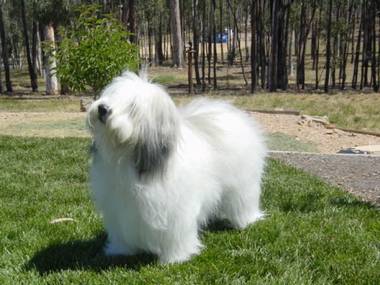
The Breed History
The Polski Owczarek Nizinny or PON was accepted into the AKC
registry in 2001. The breed may have derived from the Hungarian
group of herding dogs; some perhaps of the corded coat type. In
Poland, first records of the breed trace to about the year 1500.
During the Second World War, the breed came close to extinction.
After the war, one breeder had six bitches and two dogs which were
used to recover the breed. This is still a rare breed.
Breeding for Function
Though a sheepdog primarily developed for herding, this dog
was originally used for hunting, and also was widely valued for
companionship.
Physical Characteristics
Height at Withers: 16-20" (40.5-51 cm).
Weight: 30-35 lb (13.5-16 kg).
Coat: The double coat is accepted in any color. The coarse profuse
outer coat is shaggy and long, and the inner coat short, dense
and wooly. Colors may include white with black, or gray or sandy
patches, gray and white, or chocolate. A fading factor (dominant
inheritance) results in puppy coats fading as they mature; this does
not affect white puppies.
Longevity: 13-15 years
Points of Conformation: In general appearance, they are often
considered to be a small version of the Bearded Collie, a breed
that the PON may have acted as an ancestor for. Their overall
conformation is slightly longer than tall, cobby and heavily boned.
The skull is heavy and broad and slightly domed. The hair normally
covers the brown or hazel oval shaped eyes. The head appears
to be larger than it really is because of profuse hair, especially in
the brows, moustache and beard. The muzzle is long. The nose is
large and dark brown or black. Ears are moderate in size, hanging
down and well covered in hair. The neck is short and strong. These
dogs possess a broad level topline, and the legs are well haired.
The thorax is deep with moderately sprung ribs and the abdomen
is moderately tucked up. Limbs are straight boned and the feet
are oval, compact, and the forefeet are larger than the rear feet.
Puppies may be born tailless; if a tail is present, it is usually docked
to 2 vertebrae in length. The tail is low set. The gait is long and low
striding with an ambling appearance. These dogs may tend to toe in
somewhat.
Recognized Behavior Issues and Traits
Reported breed characteristics include: Moderate grooming needs,
friendly, high intelligence and trainability, likes to please, adaptable
to city or country living. Aloof with strangers, he makes a good
watchdog. The PON needs human companionship and regular
exercise. He is considered to have an excellent memory. Early
obedience training is strongly recommended as some of these dogs
tend to be dominant in personality.
Normal Physiologic Variations
None reported
Drug Sensitivities
None reported
Inherited Diseases
Hip Dysplasia: Polygenically inherited trait causing degenerative
joint disease and hip arthritis. OFA reports 15.8% affected.
Elbow Dysplasia: Polygenically inherited trait causing elbow
arthritis. Too few Polish Lowland Sheepdogs have been screened by
OFA to determine an accurate frequency.
Patella Luxation: Polygenically inherited laxity of patellar
ligaments, causing luxation, lameness, and later degenerative joint
disease. Treat surgically if causing clinical signs. Too few Polish
Lowland Sheepdogs have been screened by OFA to determine an
accurate frequency.
Disease Predispositions
Hypothyroidism: Inherited autoimmune thyroiditis. 28.4% positive
for thyroid autoantibodies based on testing at Michigan State
University. (Ave. for all breeds is 7.5%).
Persistent Pupillary Membranes: Strands of fetal remnant
connecting; iris to iris, cornea, lens, or involving sheets of tissue. The
later three forms can impair vision, and dogs affected with these
forms should not be bred. Identified in 6.50% of Polish Lowland
Sheepdogs CERF examined by veterinary ophthalmologists between
2000-2005.
Corneal Dystrophy: Epithelial/stromal form causes a bilateral
non-inflammatory corneal opacity (white to gray). Identified in
3.11% of Polish Lowland Sheepdogs CERF-examined by veterinary
ophthalmologists between 2000-2005.
Cataracts: Anterior cortex punctate cataracts predominate in
the breed. Identified in 2.26% of Polish Lowland Sheepdogs CERF
examined by veterinary ophthalmologists between 2000-2005.
CERF does not recommend breeding any Polish Lowland Sheepdog
with a cataract.
Neuronal Ceroid Lipofuscinosis (NCL, CL): A slowly progressive
disorder, beginning with retinal degeneration and nyctalopia from
6 months to 4-5 years of age. Affected dogs then progress to
cerebellar ataxia and dementia. Stored material in nerve and retinal
cells consisting of sphingolipid activation proteins. Suspected
autosomal recessive mode of inheritance.
Central Progressive Retinal Atrophy (CPRA): A progressive
photoreceptor degeneration secondary to an underlying abnormal
metabolism of Vitamin E. Progression is slow and some animals may
never lose vision. Undetermined mode of inheritance. CERF does not
recommend breeding any Polish Lowland Sheepdog with CPRA.
Entropion and Patent Ductus Arteriosus are reported.
Isolated Case Studies
Intracranial Medulloblastoma: A caudal fossa, cerebellar
medullobastoma was identified in a Polish Lowland Sheepdog by
MRI. The tumor arose laterally and extended to the surface of the
cerebellar hemisphere.
Genetic Tests
Tests of Genotype: None
Tests of Phenotype: Recommend hip and elbow radiographs,
CERF eye examination, patella evaluation, thyroid profile including
autoantibodies, and cardiac examination.
Miscellaneous
- Breed name synonyms: Polski Owczarek Nizinny, Valee
Sheepdog, Nizinny, PON.
- Registries: AKC, UKC (as Polski Owczarek Nizinny), KCGB (Kennel
Club of Great Britain), ANKC (Australian National Kennel Club).
- AKC rank (year 2008): 145 (78 dogs registered)
- Internet resources: The American Polish Lowland Sheepdog
Club: www.aponc.org
Canadian Polish Lowland Sheepdog Club: www.cponc.com
Polish Lowland Sheepdog Club (UK): www.plsc.org.uk
Photo Gallery of Breed - Polish Lowland Sheepdog - Dog Breed
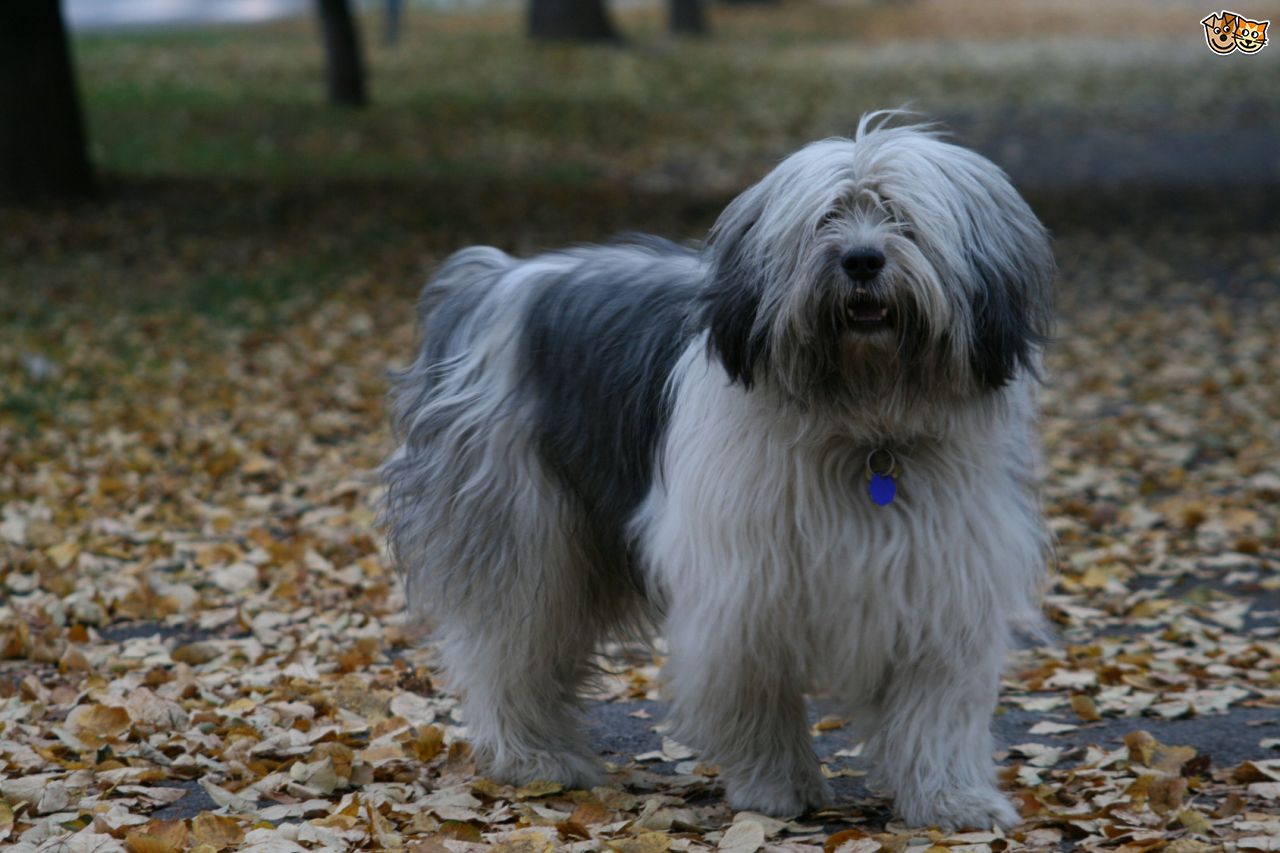


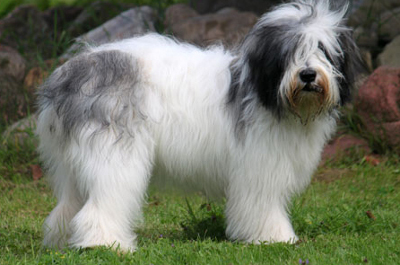

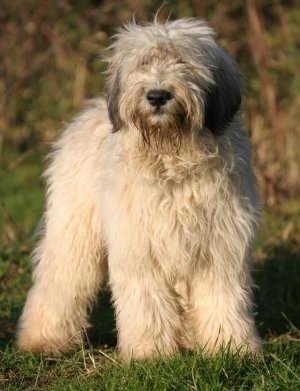
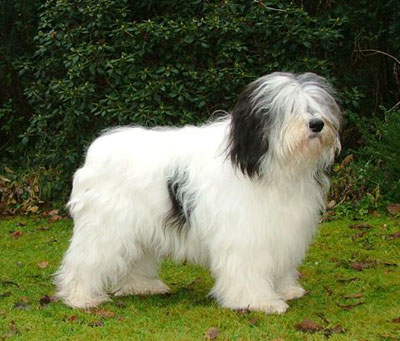
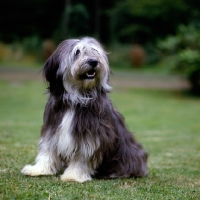
 Animalia Life
Animalia Life